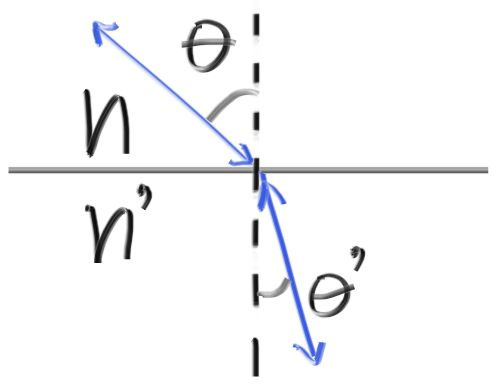물, 유리, 다이아몬드 처럼 투명한 재질은 유전체입니다. 광선을 맞았을 때, 광선은 반사광과 굴절광으로 나뉩니다. 둘중 무작위로 하나만 선택하게 두고, 유전체에 대한 광선을 처리합니다.
굴절
디버깅이 가장 어려운것은 굴절된 광선이기 때문에, 굴절된 광선먼저 진행합니다.
스넬의 법칙
스넬의 법칙에서 굴절의 공식을 알 수 있습니다.
\[\eta \cdot sin \theta = \eta' \cdot sin \theta'\]θ와 θ’는 법선에서의 각도입니다. η와 η’(“에타”와 “에타 프라임”)은 굴절률(공기=1.0, 유리=1.3-1.7,다이아몬드=2.4)이다.

굴절된 각도를 얻기위해, $sin \theta’$를 풀어야합니다:
\[sin \theta' = \frac {\eta} {\eta'} \cdot sin \theta\]굴절각의 광선 R’, 법선 n’, 각도 θ’가 있습니다. 우리는 광선 R’를 직각인 부분과 평행한 부분으로 나눌수 있습니다:
\[R' = R'_{\perp} + R'_{\parallel}\]$R’{\perp}$와 $R’{\parallel}$를 풀어보면 아래 식을 얻을 수 있습니다:
\[\begin{align*} R'_{\perp} = \frac {\eta} {\eta'}(R + cos \theta n) \end{align*} \\ \begin{align*} R'_{\parallel} = -\sqrt{1-|R'_\perp|^2 }n \end{align*}\]만약 원한다면 위 증명을 할 수 있겠지만, 그냥 넘어가도 무방합니다. 이후에 나오는 내용은 필수적으로 증명을 요구하지 않습니다.
우리는 $cos \theta$ 를 풀어야합니다. 두 벡터의 내적은 아래와 같이 표현할 수 있습니다:
\[a \cdot b = |a||b| cos \theta\]만약 벡터 a,b를 유닛벡터로 제한한다면:
\[a \cdot b = cos \theta\]$R’_{\perp}$를 위 항으로 다시 쓸 수 있습니다:
\[R'_{\perp} = \frac {\eta} {\eta'}(R + (-R \cdot n) n)\]이제 R’을 계산하는 함수를 만들어봅시다:
newtype Dielectric =
Dielectric
{ ir :: Float
}
instance Scatterable Dielectric where
scatter (Dielectric ir') ray (HitRecord p normal _ frontFace _) g =
(Just (Scattered scattered attenuation), g)
where
scattered = Ray p refracted
attenuation = Vec3 1 1 1
refracted = refract unitDir normal refractionRatio
where
unitDir = vUnit . direction $ ray
refractionRatio = bool recip id frontFace ir'
refract uv n etaiOverEtat = outPerp + outParallel
where
cosTheta = min (vDot (-uv) n) 1
outPerp = pure etaiOverEtat * (uv + pure cosTheta * n)
outParallel =
(* n) . pure . negate . sqrt . abs $ 1 - vLengthSquared outPerp
Total Internal Reflection
결과가 뭔가 이상해 보입니다. 재질이 높은 굴절율을 가졌을 때 광선에 문제가 생깁니다. 이때 스넬의 법칙만으로는 해결할 수 없어, 굴절을 사용할 수가 없습니다. 다시 스넬의 법칙으로 돌아와 $sin \theta’$의 유도를 살펴봅시다:
\[sin \theta' = \frac {\eta} {\eta'} \cdot sin \theta\]만약 광선이 안쪽이 유리, 바깥족이 공기라면 (η=1.5, η’=1.0)입니다:
\[sin \theta' = \frac {1.5} {1.0} \cdot sin \theta\]$sin \theta’$의 값이 1보다 커질수 없으므로:
\[\frac {1.5} {1.0} \cdot sin \theta > 1.0\]양변에 대해서 등호가 성립되지 않아, 해가 존재할 수 없습니다. 해가 없는 경우에는 굴절시키기 보다는 반사를 시킵니다. 보통 내부가 고체인 물체는 모든 빛을 반사시키는데, 이를 “전반사(total internal reflection)”라고 합니다. 이것이 가끔식 물-공기의 경계가 마치 완벽한 거울처럼 되는 이유입니다.
$sin \theta$를 삼각함수로 풀어낼 수 있습니다:
\[sin \theta = \sqrt {1 - cos^2 \theta}\]그리고
\[cos \theta = R \cdot n\]instance Scatterable Dielectric where
scatter (Dielectric ir') ray (HitRecord p normal _ frontFace _) g =
(Just (Scattered scattered attenuation), g')
where
(randFloat, g') = sampleFloat g
scattered = Ray p refracted
attenuation = Vec3 1 1 1
refracted =
if (let cosTheta = min (vDot (-unitDir) normal) 1
sinTheta = sqrt $ 1 - cosTheta ^ 2
in refractionRatio * sinTheta > 1)
then vReflect unitDir normal
else vRefract unitDir normal refractionRatio
where
unitDir = vUnit . direction $ ray
refractionRatio = bool id recip frontFace ir'
유리는 아무것도 흡수하지 않기 때문에, atteunation 가 항상 1입니다.

슐릭 근사
현실의 유리는 각도에 따라 다양하게 반사됩니다 - 창문을 특정각도로 보면 거울이 되기도 합니다. 여기엔 아주 이상한 식이 많이 있지만, 하지만 대부분은 ‘Christophe Schlick’이 만든 빠르고 정확한 다항 근사식을 사용합니다.
instance Scatterable Dielectric where
scatter (Dielectric ir') ray (HitRecord p normal _ frontFace _) g =
(Just (Scattered scattered attenuation), g')
where
(randFloat, g') = sampleFloat g
scattered = Ray p refracted
attenuation = Vec3 1 1 1
refracted =
if (let cosTheta = min (vDot (-unitDir) normal) 1
sinTheta = sqrt $ 1 - cosTheta ^ 2
in refractionRatio * sinTheta > 1 ||
reflectance cosTheta refractionRatio > randFloat)
then vReflect unitDir normal
else vRefract unitDir normal refractionRatio
where
unitDir = vUnit . direction $ ray
refractionRatio = bool id recip frontFace ir'
reflectance cosine refIdx =
let r = (^ 2) $ (1 - refIdx) / (1 + refIdx)
in r + (1 - r) * (1 - cosine) ^ 5